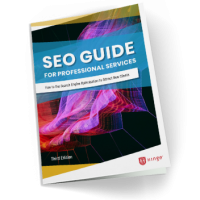Understanding the basics of B2B SEO (search engine optimization) is difficult for people that don’t specialize in the practice. Why wouldn’t it be? Google is constantly changing the way it indexes and ranks pages in search results. It seems so very covert how Google remains secretive about what works and what doesn’t work to improve those rankings. With that said, there are ways to succeed with B2B SEO. It all comes down to creating a strategy and sticking to it.
Before we get into the weeds of content creation, optimization, and promotion, let’s discuss a few key “on-site” SEO basics.
On-site optimization—The foundation of your B2B SEO strategy
Two elements of basic website infrastructure must be in place for B2B SEO to be effective.
- The first element is a blog. A blog is crucial because it contains content that can be created easily and often. Blog posts are also going to be the main driver of traffic for your website and the main source for additional future traffic. Your blog is the “bait” that shows up in search engine results. It should answer users’ questions.
- The second element of infrastructure is an area on your website dedicated to your educational content. This area is usually your “Resources” or “Library.” Longer form content (guides, white papers, webinar recordings, ebooks etc.) lives here. This content is your source for conversions. Each piece should be comprehensive enough to ask a visitor for an email address. Many firms make the mistake of including promotional materials and news about themselves in this area. Avoid this tendency and only include educational, non-promotional content.
Now that we have the basic infrastructure set up, it’s time to ensure you are properly optimized for search engines.
Proven B2B SEO Practices
Let’s start with a few B2B SEO best practices
Best Practice #1: Keep your titles under 60 characters
It isn’t always possible, but keeping your blog post titles short will ensure the entire title appears in search results.

Best Practice #2: Add a compelling meta description (under 160 characters)
In search results, the description under the clickable title is called the meta description or page description. This should be a broad description of your content and entice a user to click through. These descriptions can be incredibly helpful in improving your click-through rate.
Best Practice #3: Identify relevant keywords that are being searched
Your prospects are looking for solutions to problems they are having with their own business. How can you help them? Well the best place to start is to learn what they are actually typing into search engines. So take time to learn how to do keyword research effectively.
Best Practice #4: Ensure your blog can be shared
One of the best ways to boost your content’s rankings is to gain links from other websites. Making it easy for users to share your content will get it in front of a much larger audience.
Content creation—issues & topics
To be strategic, you must first understand what prospects need to know. What are their pain points? What is keeping them up at night? What kind of questions do they need answers to? The answers to these questions are your high-level “issues” that will shape your content strategy.
The best way to go about getting to your issues is to consult with the people in your firm who converse daily with your prospects and clients. These are usually the same folks that are in some way involved in the business development process.
Download the Free “SEO Guide” Now
These higher level issues will encompass a number of different “topics.” Let’s use this post as an example:
What is the issue? It could be “How to attract new business” or “ business development.” These are rather broad issues and there are numerous topics that could be covered by this particular post. Like “SEO for lead generation” or “targeting the right audience.”
Create a list of different issues and specific topics that fall under each. At this point, you’re ready to begin keyword research. Let’s use the “targeting the right audience” topic to come up with a few keywords that we could consider. Here are a few I found:
- audience targeting
- targeted marketing
- market segmentation
Use one keyword to formulate a title for your blog post. (Best practice #5: Insert your keyword as close to the beginning of your title as possible)
Once you have a list of usable titles you are ready to start creating content. Use each topic as a separate blog post. You can then create a comprehensive guide based on a high-level issue with several blog posts serving as the basis for each chapter or section of your guide, which you share in your Library.
Promoting your content—Amplification (off-site SEO)
The final piece of your B2B SEO strategy should focus on content promotion.
If you are just posting a blog on your website every week and not promoting it, you are limiting your chances to drive additional traffic that may lead to content downloads and conversions.
Promoting your content strategically will not only get it directly in front of influencers and decision makers, but will also lead to natural links coming back to your domain. Again, a major, if not the most important factor Google uses to decide rankings.
Here are a few popular methods for promoting your content:
LinkedIn Groups
We all know LinkedIn is great for B2B marketing, but many firms fail to use LinkedIn Groups. By identifying highly relevant groups and sharing your content within those groups, you are exposing your content to a much larger audience than just the followers of your company page.
Let’s say your company page has 500 followers. The total possible reach if you post to your company page is going to be—you guessed it—500. Now you post to your company page as well as to Group ABC, which has 58,000 members, and Group DEF, which has 5,000 members. Your total possible reach is now 63,500.
Blogger Outreach
Google has scared some into thinking guest blogging is bad. It can be if you are guest posting on and getting links from low-quality, irrelevant blogs. For example, if you, an engineering firm, are getting links from a cupcake blog.
The right way to promote your great engineering content would be to go to a high-authority, highly relevant blog like Engineering.com. Big publishers are always looking for great content. Feel free to reach out and pitch them an idea you’d like to write about. Many high-authority blogs make this easy and are more than happy to link back to your site in some way (through either an author bio or link within the body of your post).
Stay in for the long term
Any strategy you create should be adjustable. Regularly monitor your progress, monthly if not weekly. Is your traffic growing? Which pieces of content are performing the best? Which LinkedIn Groups are you getting the most engagement in? Are you getting more leads?
Download the Free “SEO Guide” Now
All too often, firms abandon their strategies far too soon or, even worse, have no strategy at all. Realize that you are not going to triple your traffic and leads in three months. It doesn’t work that way. It usually takes at least 6 months of content creation, optimization, and promotion to see real results.
If you have struggled with where to start on putting together a effective B2B SEO strategy, hopefully this post will point you in the right direction. Feel free to ask any additional questions you might have in the comments below. Have any other tactics worked well for you?
How Hinge Can Help
Create a website that’s easy to find and provides a positive user experience. Our High Performance Website Program helps firms drive online engagement and leads through valuable content. Hinge can create the right website strategy and design to take your firm to the next level.
Additional Resources
- Learn more about increasing your firm’s SEO performance in our SEO Guide for Professional Services Executives.
- Our Lead Generating Website Guide details how your firm can generate qualified leads with its website.
- Learn about the most effective online marketing strategies to generate leads in our Online Marketing for Professional Services book.





